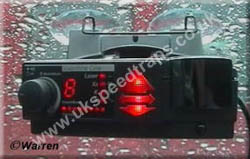Valentine One

Valentine One unit, in start up mode.
You can also see the bar linking the two window suckers
together for quick release of the whole unit.
Note: This is now been replaced by the new slimmer model.
Known as the Class leader by most drivers, this is the yet another
unit that offers outstanding performance when it comes to detection
it's performance is brilliant it's price however
is not, but then they do say it's Reassuringly Expensive.
Costing a whooping £579.95 RRP
The Valentine one came with a windscreen mount,
visor mount with one hand quick release, two power cables and
hard wire box and cable. (This allows you to have a permanent
power connection on your vehicle). All the cables connected via
RJ-11 telephone connectors, a neat way of doing things and it
became more apparent why when you see how all the accessory's
link into the system.
It's a solid well-made unit with a quality
feel not the most stylish of units but never the less
it looks the business. The Valentine One has to twin radar detecting
aerials and twinned laser detecting diodes. The twin aerials one
aimed forward and one rearward this gives it its ability to triangulate
where the signal is coming from including the Laser signal.
This I found to be very useful in practice it shows
you where the signal is coming from so you know where to look.
Optional accessory's come in the form of a Remote
Audio Adapter (£34.95), This gives you the ability to connect
an earpiece and speaker, control the volume and computer settings,
ideal for motorbikes.
A concealed Display option (£39.95 mimicked the
main display and allowed you to keep a lower profile by moving
all the display lights elsewhere a very cleaver feature of the
concealed Display was it connected to the cigarette power adapter
via a slide mount or you can place it else where in the car with
another mounting option. It all added up to a very neat package
without masses of wires as well.

Valentine One Remote Audio Unit.
The Unit is designed for left-hand drive vehicles,
(the display and buttons slant to the left), this is not a major
issue but it would have been nice to have it flat on the front
for us British drivers.
One of the most obvious features on front of the Valentine One
is the collection of three arrows, called direction indicators they are used to inform the driver where the danger is, front,
back or sides. It's also the only unit that I've reviewed so far
that can deal with multiple radar signals, the display on the
front will display the No. 1-5 depending on the amount of radar
signals in the area and LED's identify the frequency and signal
strength.
This I found out was worth its weight in gold, we
did a test using a Hand held gun and a Gatso nearby, all the other
units just told me I had a signal, but not how many. The Valentine
One told me there was two signals and where they were. As I passed
the Gatso the arrows went from front to side and then to back
but the front arrow stayed light telling me that there was another
signal in front of me. The bogey counter also said that there
were two signals on the K band. This situation would not happen
often in real life but it's nice to know that this unit could
cope, and in a real situation with a standard radar detector I
would have thought it was just the Gatso giving the signal.
The Valentine also has two volume control dials,
one for Master volume and one for mute volume. The initial volume
is used to warn you of the threat and then the unit goes over
to mute volume, this is allows you set the volume of the reminder.
In the alarm mode the direction of the signal,
the band of the signal, i.e.. K band and the strength of the signal
are all displayed on the front to the unit.
There are also three selectable computer modes
used to identify radar signals and help reduce false alarm signals.
So what tests did we do?
The most important one is the Gatso Test. We have
a section of road that we use for all Gatso tests, it has one
of the lowest radar scatter fields making it more of a challenge
to Radar Detectors it also allows us to do the national speed
limit if we want to. All the Radar detectors are tested in the
same vehicles and in the same position on the windscreen.
The Valentine One was subjected to three passes
using a stopwatch to time the unit from the first beep to the
point of passing the Gatso to establish an average warning time
. Speed was 60mph. Please note warning times can vary subject
to conditions.
Times for the Gatso Test. Roadside FIP
| Approaching Back of Gatso |
Approaching Face of Gatso. |
|
|
Times for the Gatso Test. M25 Gantry Gatso.
Important Note: The Gatso Used was a solo
Gantry Gatso on the M25 Motorway. Speed was 80mph
We had the information confirmed by a contact in the Met that
no other Gatso was working within 2 miles, this is important
since another Gatso near the area can effect the results in
a major way since they are mounted so high.
| Approaching Back of Gatso |
Approaching Face of Gatso. |
|
|
Laser Gun Test.
The Laser gun was used in two ways, the first test
was directly at the car with the detector in it, although the
detector worked and was instant on alarm, if the officer used
the first reading you were in trouble. However they often take
a few readings so you may have a chance to slow. The second test
was to have two cars in front and the operator target the first
car and see if there was enough scatter for the third car to get
an alarm, it was not a problem for the Valentine we had an alarm
in all three runs.
In our opinion you could get a warning or you could
get nicked when it come to the Laser alert mode.
False Alarm Test.
This is done over a six mile selection of roads
taking in two Gatso's and a town centre with Banks, Supermarkets
and DIY stores.
We had three alarms on the K band and four on the
X band (X band we thought could not be turned off on the Valentine
1 however an e-mail from Rav a reader of the site told us it can
and how to do it.) The amount of false alarms is important, if
it spends all its life beeping at you, you will soon start to
ignore it. However the Direction indicators allowed you to identify
the location of the signal very quickly
I been using the unit now for a few weeks and with the X band
now turned off I have taken to this unit in a big way. It no longer
beeps all the time it just sits there and does its job well, Very
Well.
UPDATE: After a 6 months use, comparing it to
the Bel 990 the Valentine One false alarms the least and is by
far worth the extra money, If you can stretch to the extra money
it is worth it.
Can we recommend it, YES, we can.
It's still one of the best, even if they do say
its Reassuringly Expensive.
| What do we like. |
What don't we like. |
- It's performance
- Clear easy to read display
- Loud Clear Sounds
- Quick release windscreen mount
- User functions
- Signal direction indication
- Multiple threat capability
(big plus)
- Accessories integration
- Build Quality
- Automatic display dimming
- Very informative Instructions
- Good choice of mounts
|
|
|




